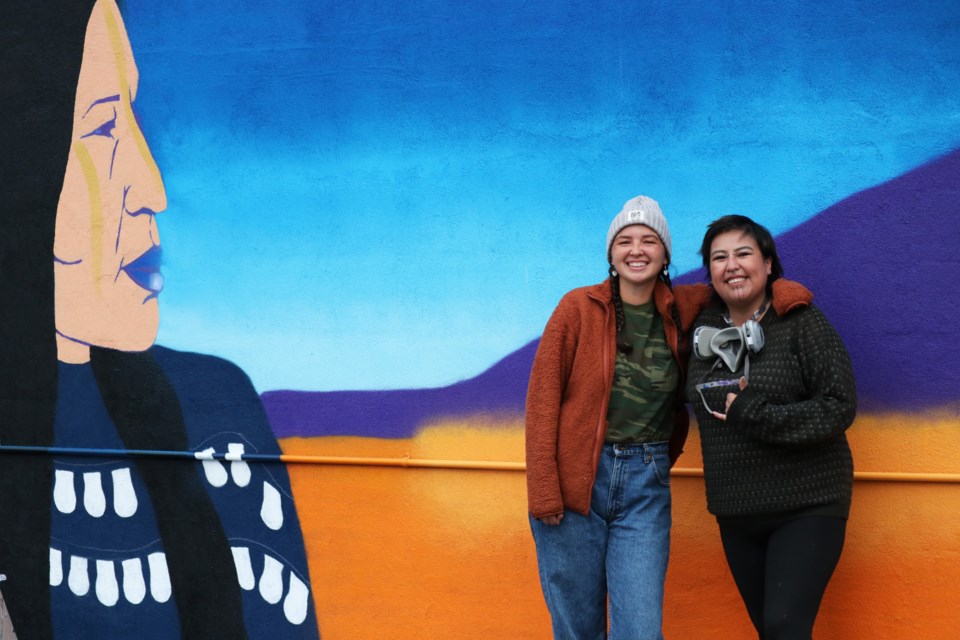CANMORE – Canmore’s newest and largest outdoor mural is giving new meaning to three of the town’s most prolific peaks.
Beneath the gaze of the Three Sisters, Indigenous artists Kayla Bellerose and Cheyenne (Chey) Suwatâgâ-Mu, are sharing a story that reclaims the mountains and their history for the area’s traditional territory holders – Îyârhe Nakoda First Nation.
“This mural project is clarifying the story and the importance behind the mountains for us,” said Suwatâgâ-Mu, of the Nation’s Bearspaw band. “The association of the mountains with nuns just sort of whitewashes everything.”
The mountains were originally named the Three Nuns by Albert Rogers in 1883 after a heavy snowstorm veiled the northern faces of each peak. In 1886, George Dawson gave them their present-day name, not a far reach from the original.
The Îyârhe Nakoda refer to the peaks as the Three Sisters, but some say the name refers to the story of an old trickster, Ĩ-ktomnĩ, who would promise ‘three sisters’ in marriage whenever he was in trouble.
Suwatâgâ-Mu and Bellerose, also known by her artist name bb iskwew, have a different interpretation of what the three peaks represent.
The mural, spray-painted onto the west-facing wall of the old Canmore Visitor Centre, depicts three unnamed Indigenous women looking upon the snow-capped Three Sisters under the glow of a full moon, with deep shades of red and vibrant hues of pink, purple, orange and blue throughout.
The artists’ shared vision was to showcase a design that exhibits the strength and fortitude of all of the area’s Indigenous people, but particularly the women.
“With all the findings at former residential school sites over the past year-and-a-half, I find myself always just thinking about the grandmothers and the mothers whose children were taken from them,” said Bellerose.
“I feel like this mural tells a story of not only the Three Sisters, but also just the women from this territory who experienced that trauma and have shown their power and resilience in the face of it.”
Bellerose, a Cree woman originally from Slave Lake in Treaty 8 territory, said it was hosting an art workshop in Mînî Thnî that inspired a theme around the peaks.
There, she heard another interpretation of how they get their name. This story depicted the sisters as three respected Îyârhe Nakoda women with families still living today.
Some of the details of that story are fuzzy, Bellerose said, but hearing and sharing it with Suwatâgâ-Mu left the two intrigued to know more and moved them to create a modern portrayal.
The artists submitted their mural design earlier this year after the Town of Canmore made a callout to Indigenous artists in Treaty 6, 7, and 8, the Métis Nation of Alberta Region 3, and the unceded territory of B.C.
Theirs was selected through a blind two-tiered jury submission process. It is the first piece of Indigenous art commissioned by the Town.
The jurors, who could not see any of the artists’ names, appreciated Bellerose and Suwatâgâ-Mu’s design for what it represents, but also because it stands in sharp contrast to much of Canmore’s existing public art.
Although she wasn’t part of the jury, arts and events coordinator Nicky Pacas heard a lot of positive feedback about the “incredible vibrancy” of the mural design.
“On cold, gloomy days in Canmore when the clouds are low and we can’t see the mountains, there’s a lot of grayness in the downtown core,” she said.
“This mural really stands in juxtaposition to a lot of pieces in our public art collection which are made of heavy materials like steel and stone.”
The mural wall used to be home to a stark black and white mural memorializing Canmore’s coal mining past. The painting was replaced because it had outlived itself, weathered by outdoor elements over the years.
In addition to brightening up downtown, Pacas said the project is an important piece of the Town’s ongoing Truth and Reconciliation efforts.
Bellerose and Suwatâgâ-Mu also had the opportunity to undergo a brief artist residency in Canmore, along with the other top three selections, in order to familiarize themselves with the community and its arts scene before tackling the mural project.
“This is really exciting for us at the Town of Canmore. We’re working really hard to meet the recommendations of the Calls to Action from the National Truth and Reconciliation committee,” said Pacas.
“Having a piece of art like this is not just aesthetics, but it is a meaningful step for us to building bridges and recognizing that community can look different, and that we’re still building together.”
The mural, which took the two artists from Sept. 6 to 15 to complete, was unveiled on Sept. 16.
The Local Journalism Initiative is funded by the Government of Canada.




